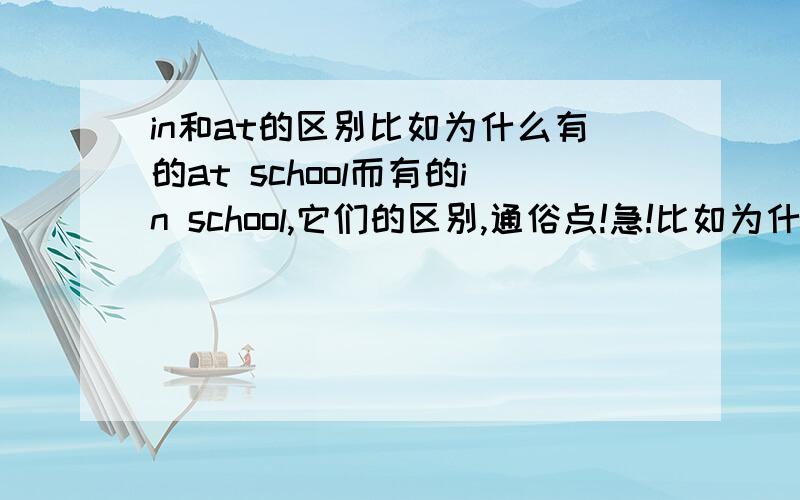in和at的区别比如为什么有的at school而有的in school,它们的区别,通俗点!急!比如为什么有的at school而有的in school,它们的区别,通俗点!!!急!!!!!!! (举例) 2.see和watch,look的区别 (
来源:学生作业帮助网 编辑:作业帮 时间:2024/07/27 17:17:35

in和at的区别比如为什么有的at school而有的in school,它们的区别,通俗点!急!比如为什么有的at school而有的in school,它们的区别,通俗点!!!急!!!!!!! (举例) 2.see和watch,look的区别 (
in和at的区别
比如为什么有的at school而有的in school,它们的区别,通俗点!急!
比如为什么有的at school而有的in school,它们的区别,通俗点!!!急!!!!!!! (举例)
2.see和watch,look的区别 (举例)
in和at的区别比如为什么有的at school而有的in school,它们的区别,通俗点!急!比如为什么有的at school而有的in school,它们的区别,通俗点!!!急!!!!!!! (举例) 2.see和watch,look的区别 (
at school 是指在上学,指的是在做学习这件事
In school 只是在学校,指人的地理位置是学校内,与其是否从事学习这件事没关系
也就是说,一个是指学习这件事,一个是指地理位置.
一. in,on在方位名词前的区别
1. in表示A地在B地范围之内。如:
Taiwan is in the southeast of China.
2. on表示A地与B地接壤、毗邻。如:
North Korea is on the east of China.
二. at, in, on在表示时间上的区别
1. at指时间表示:
全部展开
一. in,on在方位名词前的区别
1. in表示A地在B地范围之内。如:
Taiwan is in the southeast of China.
2. on表示A地与B地接壤、毗邻。如:
North Korea is on the east of China.
二. at, in, on在表示时间上的区别
1. at指时间表示:
(1)时间的一点、时刻等。如:
They came home at sunrise (at noon, at midnight, at ten o’clock, at daybreak, at dawn).
(2)较短暂的一段时间。可指某个节日或被认为是一年中标志大事的日子。如:
He went home at Christmas (at New Year, at the Spring Festival, at night).
2. in指时间表示:
(1)在某个较长的时间(如世纪、朝代、年、月、季节以及泛指的上午、下午或傍晚等)内。如:
in 2004, in March, in spring, in the morning, in the evening, etc
(2)在一段时间之后。一般情况下,用于将来时,谓语动词为瞬间动词,意为“在……以后”。如:
He will arrive in two hours.
谓语动词为延续性动词时,in意为“在……以内”。如:
These products will be produced in a month.
注意:after用于将来时间也指一段时间之后,但其后的时间是“一点”,而不是“一段”。如:
He will arrive after two o’clock.
3. on指时间表示:
(1)具体的时日和一个特定的时间,如某日、某节日、星期几等。如:
On Christmas Day(On May 4th), there will be a celebration.
(2)在某个特定的早晨、下午或晚上。如:
He arrived at 10 o’clock on the night of the 5th.
(3)准时,按时。如:
If the train should be on time, I should reach home before dark.
三. at, in和on表示地点时的区别
1. at表示地点:
(1)用于指较小的地方。如:
I shall wait for you at the station.
(2)用于门牌号码前。如:
He lives at 115 Zhongshan Road.
2. in表示地点:
(1)用于指较大的地方。如:
He lives in Shanghai.
(2)虽然是很小的地方,如果说话人住在那里,也可用in。商店、学校、机关等,若看作一个地点(point)用at,若看作一个场所(place)用in。如:
I met him at the post-office.
I’m now working in the post-office.
3. on表示地点,一般指与面或线接触,意为“在……上;在……旁”。如:
The picture was hanging on the wall.
New York is on the Hudson River.
一定要选我叻!!!!!!!!!!!!!!!!!!!!!!!!!!!!!!!
收起